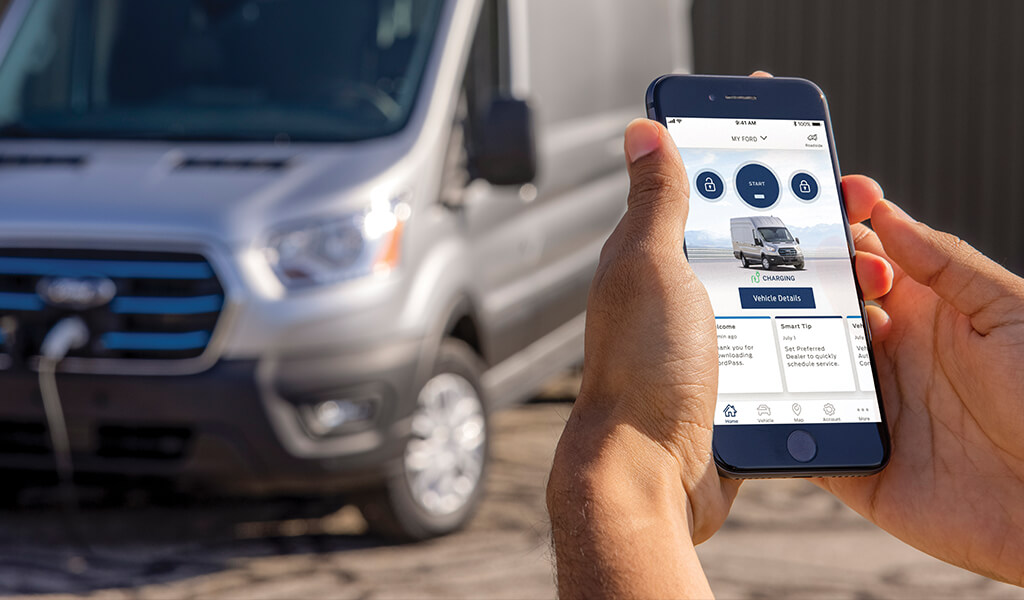Conventional wisdom says that it will take several more years before electric vans make a dent in the expedited trucking market. But the recently revealed 2022 all-electric Ford E-Transit, with a $45,000 starting price, shows that fully capable and affordable battery-powered vans might be coming sooner than we think.
So, what does this mean for expediters? Is an electric van, like E-Transit, ready for prime time in the expedited trucking industry?
Here’s what we know so far about E-Transit, which is slated for production late this year.
What’s the range between charges?
The range is an estimated 126 miles with the low-roof configuration.
There’s no word from Ford about how much the payload numbers factor into that range, which is important because the heavier the load, the more battery power required to haul that weight, which reduces range.
Also, most expediters prefer the high-roof van, which shortens the range by creating more wind drag than the low-roof models.
How long does it take to charge?
E-Transit features both AC and DC fast charging, coming standard with a Ford Mobile Charger that can plug into a conventional 120-volt outlet for slow and steady charging or into a 240-volt outlet for faster charging.
Those seeking the fastest home charging solution can purchase the Ford Connected Charge Station, which can fully charge E-Transit in eight hours.
On a 115-plus-kilowatt DC fast charger, E-Transit cargo van low-roof models can achieve approximately 30 miles of range in 10 minutes and about 45 miles of range in 15 minutes.
When plugged into a 240-volt outlet, E-Transit cargo van low-roof models achieve approximately 10 miles per charging hour using the Ford Mobile Charger. If you use a Ford Connected Charge Station, the number goes up to around 15 miles per charging hour.
What is the payload capacity?
Ford targets a maximum payload of 3,800 pounds for the E-Transit cargo vans and up to 4,290 pounds for cutaway versions.
What configurations will be available?
E-Transit offers eight configurations, including three roof heights and three lengths, plus chassis cab and cutaway models.
What are E-Transit’s horsepower and torque ratings?
Ford expects E-Transit to generate 266 horsepower/198 kilowatts of power and 317 lb.-ft. of torque across all configurations, which should be sufficient for most expedite applications.
How extensive is the service network?
This is an important question whenever you’re trying a new powertrain technology. After all, who is going to work on the vehicle if it breaks down?
E-Transit is backed by Ford’s network of 1,800-plus global commercial vehicle dealers, including 645 commercial vehicle centers across the U.S. – about 90 percent of which are electric vehicle-certified.
What safety features will be available?
E-Transit offers Ford’s new Co-Pilot360 technology, with available Intelligent Adaptive Cruise Control with Speed Sign Recognition and Intelligent Speed Assist, which together identify speed limits and automatically change the vehicle speed accordingly.
Co-Pilot360 system also includes standard Lane-Keeping System and Pre-Collision Assist with Automatic Emergency Braking. Available features include Blind Spot Information System with Blind Spot Assist, a 360-degree camera and Reverse Brake Assist.
The Bottom Line
E-Transit makes a compelling case that all-electric could be the (not-so-distant) future of expedited trucking, at least in the van segment. It offers sufficient power, payload capacity and a full suite of safety features you would expect in gas and diesel models at an affordable starting price of $45,000.
But one big hurdle remains: Range. The battery range will need to double – or even triple – without substantially raising the price for an all-electric van to be practical for most expedited trucking applications.
Watch this space.
